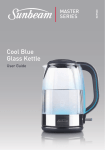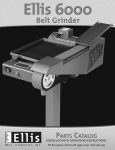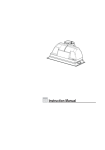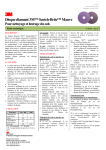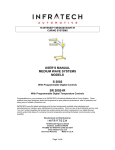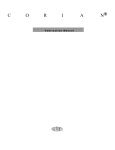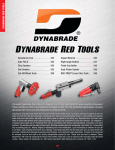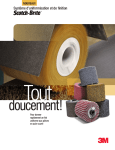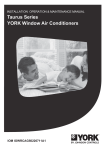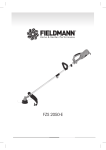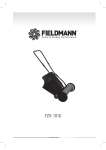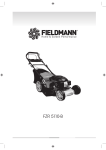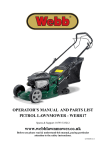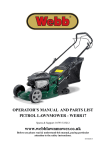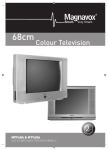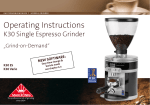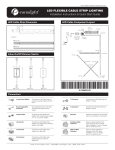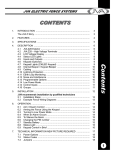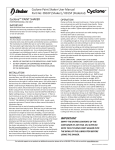Download User Manual - Trick
Transcript
Multitool WWW.MULTITOOLGRINDER.COM SAFETY INSTRUCTIONS WARNING: To avoid mistakes that could cause injury, do not use the Multitool until you have read and understood the following: 1. 2. 3. 4. 5. 6. 7. 8. 9. 10. 11. 12. ALWAYS WEAR EYE PROTECTION. A full-face visor is preferred. Any Belt/Disc Grinder can throw foreign objects into the eyes. AVOID EYE CONTACT WITH BELT OR DISC. The abrasive belt when running is an aggressive cutting tool. Extra care should be exercised when using coarse grit belts because of their rapid cutting action. KEEP CHILDREN AWAY. All visitors should be kept a safe distance from the work area. BOLT THE BENCH GRINDER securely to the bench or supporting surface to stop it from tipping over or moving when in use. DO NOT MOUNT the attachment protruding into walkways. KEEP WORK AREA CLEAN. Cluttered areas and benches invite accidents. ALWAYS WEAR A DUST MASK to prevent dust inhalation when adequate ventilation or extraction is not available. DO NOT WEAR LOOSE CLOTHING, which may become entangled in the machine. Wear protective hair covering to contain long hair. ALWAYS HOLD the work piece firmly when grinding and apply a light and steady pressure against abrasive disc or belt. ALWAYS GRIND ON THE DOWNWARD SIDE of the grinding disc. Grinding on the upward side of the disc could cause the work piece to fly out of position, resulting in injury. DO NOT USE BELTS THAT ARE DAMAGED, TORN, OR SHOW SIGNS OF WEAR ALWAYS INSTALL BELTS with arrows in the back of the belts pointing the correct direction. Belts with lap joints must be fitted facing the correct direction. See sketch below. INTRODUCTION TO BELT GRINDING Belt grinding or finishing has many advantages over the use of conventional grinding wheels. It is possible to remove material up to 5 times faster than the equivalent grade of grinding wheel with far less heat. The electrostatic process used in the manufacturing of an abrasive belt ensures that the sharp side of each piece of grit is facing outwards on the belt thus giving cleaner, smoother and faster cutting. The flexing of the belt has a self-cleaning and cooling action, making it more suitable to any application where heat could damage the work such as grinding leather, plastics, tool sharpening etc. BELT APPLICATIONS ALL METALS COARSE FINISH MEDIUM TO FINE VERY FINE MICROFINISHING HEAVY GRINDING ALUMINUM Always use belt grease to prevent clogging. WOOD Use Aluminum Oxide Resin Bond (open or closed) 40, 60, 80, 100 or 120 Grits Use 40 to 80 Grit Use 120 to 180 Grit Use 220 to 400 Grit Use 3M Trizact 700 to 1200 Grit Use Zirconia Belts 24, 40 or 80 Grit PLASTICS & GLASS CERAMIC Use Silicon Carbide Resin Bond 40 to 600 Grit BELT AND DISC GRINDING ATTACHMENT OPERATING INSTRUCTIONS BELT CHANGING To remove the belt simply push down on the underside of belt to compress the tensioner assembly. Catch automatically holds the slide in retracted position. When refitting the belt simply release the catch (Fig 3:O) Always make sure belt lap faces the correct direction (see diagram left). BELT TRACKING Always ensure the belt entirely covers the rubber contact wheel. Adjustment is made when running or when belt is rotated by hand. To adjust left, move tracking lever down. To adjust right, move lever up. If tracking lever is constantly set in up or down position refer to Figs 5 & 6 of fitting instructions on reverse side. PLATEN GRINDING (HORIZONTAL OR VERTICAL) It is important that the Platen (Fig 4: P) is not set too high. If belt is deflected and rides up over the platen it creates an undue strain on the grinder, especially when starting. If platen is not often used it is better to set a little clear of the belt. A simple method to adjust the platen is to place a straight edge on top of the belt between the contact wheel and drive pulley and raise platen so that it just touches under side of belt. Work of any length can be surfaced on the platen, for example the saw edges of wood from short pieces up to lengths of several feet. Never grind or sand on platen unless you are sure belt lap is facing in correct position (See diagram at left). DISC GRINDING Whenever possible remove the belt when using the grinding disc. The disc grinder is a very versatile part of the attachment that can be used for dressing small castings and components, patterns, models etc. often eliminating costly machining. Tool and cutter sharpening is a simple task and there is less chance of burning edges. With the addition of the table, lengths and angles are easy to adjust. Dressing end grain flat and square has always been a difficult task but now it is a simple and quick operation, making perfect joints possible. A rubber cleaning stick should be used regularly to prevent build up wood resin. When changing a disc pad remove any remaining adhesive with a solvent, e.g. Lacquer thinner, acetone (nail polish remover). Do not use household cleaners. CONTACT WHEEL GRINDING, POLISHING, AND SANDING Using the front contact wheel removes material many times faster than a conventional grinding wheel. The unique smooth cutting action is cooler, faster and safer than conventional grinding methods. A good example of one of the many uses is the smoothing of welds and casting blemishes prior to plating. Using the extremely fast and easy belt change it is possible to go from a rough weld finish to a flat, smooth polish suitable to chrome plate in only two belt changes. e.g. Remove rough weld with 40 or 80 grit belt. Remove grinding marks with 240 grit belt. Change ground finish to smooth, brushed finish for plating using Scotchbrite super fine or Trizact belts. Wood shaping and finishing can be done in a similar manner but belts should always be kept exclusively for wood, especially in the finer grades. A rubber belt cleaning stick helps prevent clogging on wood use. FREE STRAPPING Free strapping is a method of belt grinding, sanding or polishing where no backing is used behind the belt. It is especially suitable for round and contoured work and some sharpening operations. It is done on the underneath side of the belt opposite the platen. Belt grits of 180 to 400 are recommended because of the rapid cutting action. ATTACHMENT SPECIFICATIONS MULTITOOL 362 Belt size 36” x 2” - Disc size 7” - Contact Wheel 3½” diameter. Fits most 6” or 8” bench grinders with minimum ⅓ H.P. and shaft sizes of ½” or ⅝”. MULTITOOL 482 & MULTITOOL 8CW Belt size 48” x 2” - Disc size 7” - Contact Wheel 3½” diameter (8” diameter on 8CW). Fits most bench grinders with minimum ½ H.P. and shaft sizes of ½” or ⅝”. MULTITOOL 364 Belt size 36” x 4”- Disc size 7” - Contact Wheel 3½” diameter. Fits most 6” or 8” bench grinders with minimum 3/4 H.P. and shaft sizes of ½” or ⅝”. (Note: Drive pulley can be bored to maximum 1”.) MULTITOOL 484 Belt size 48” x 4” - Disc size 7” - Contact Wheel 3½” diameter. Fits most bench grinders with minimum 1 H.P. and shaft sizes of ½” or ⅝”. (Note: Drive pulley can be bored to maximum 1”.) BELT SPEED – ALL MODELS - Approximately 5000 Ft/min AVAILABLE ACCESSORIES ADJUSTABLE ANGLE WORK TABLE (MTBL) - for Disc Grinding SHARPENING JIG (MTSJIG) – for sharpening chisels and planer blades POLISHING ROUGE (MTRouge) - for use with Polishing Belts WARRANTY AND CONDITIONS OF SALE The words “us”, “we” or “our” refers to P.A Products or their authorized agent A.) The warranty will only apply if the fitting and operating instructions are followed. B.) The warranty will only apply for a period of 1 year from the date of original purchase against any defect in our product, which can be proved, to our satisfaction to have been caused by faulty materials or workmanship. Our liability is limited to the cost of repairing or at our option, replacement of the defective goods or parts of the goods. We will not be liable for any defect caused by unauthorized repair. INSTRUCTIONS TO FOLLOW FOR WARRANTY CLAIMS: 1. If warranty claim is made, we must be notified as soon as possible after assumed defect has become apparent. 2. Goods may only be returned with the approval and RGA # from Van Sant Distributing, Inc. 800-828-2043 or email us at [email protected]. 3. The customer must prepay all freight charges for returned goods. 4. We will contact the customer with a suggestion after inspecting the goods to determine with the customer what action should be taken in the circumstances. FITTING INSTRUCTIONS - ALL MULTITOOL MODELS 1 E 2 B 4 3 Scan for Video Disconnect grinder from power source. From the right hand end of the grinder, remove wheel cover, wheel, wheel flanges and wheel guard. Fit slotted adaptor plate (A) using either ¼” bolt (1), 5mm Bolt (2) or 3/16” Bolt (3) provided. Use appropriate size washers under heads (B). The outer edge of the adaptor plate is tapered. Face smallest side of taper away from grinder as shown in Fig 1: A. NOTE: On 8” JET brand grinders use two additional washers between the grinder and adaptor plate to clear flat head carriage bolts (Fig 2: E). Scan for Video Fit the Main Bracket (D) using flat head carriage bolts (E) through the three cut outs (Fig 1: C) with flat head of bolt facing the drive pulley.* With angle face of bracket approximately vertical, tighten ¼” nuts (4) evenly. If the Multitool is to be used in a vertical position simply loosen nuts, tap main bracket (D) to loosen. Swivel to desired position and retighten nuts (4). The above cutaway view is from the rear of the right hand end of the grinder showing the tapered fit of the adaptor plate (A) and main bracket (D). *NOTE: If interference occurs, insert carriage bolt with head facing the grinder motor. 5 J F G 6 Scan for Video Fit the idler arm (H) using 5/16” diameter bolts (J) and washers (5) provided. Fit one of the heavy dished flanges (G) provided in the kit, that suits either ½” or ⅝” diameter shaft size and check that it clears heads of bolts (Fig 1: B). If there is interference, use either ½” or ⅝” diameter washer (pictured above and in Fig 2: F) behind the flange. The drive pulley (Fig 4: K) comes with a 5⁄8” bore, there is a 1⁄2” steel bushing (6) provided for smaller shafts. NOTE: The 4” Drive Pulley in the Multitool models 364 & 484 can be bored to a maximum of 1”. Scan for Video Fit the Drive Pulley (K) by sliding over the shaft of the grinder. Fit tightly against the heavy dished flange (Fig 3: G) and use the 1⁄2” or 5⁄8” diameter washer (Fig 3: F) under the nut and tighten with a socket or wrench. NOTE: A poor quality nut may prevent pulley from running true. If this is the case, replace factory nut with high quality alternative. 7 8 Scan for Video Idler arm Cam plate (M) must now be set ¼” (6mm) clear of inside edge of the drive pulley (Fig 4: K) Slots are provided under 5⁄16” bolts (Fig 3: J) for this adjustment. Set tracking lever (N) in mid or horizontal position. Fit the belt and release spring loaded contact wheel by lifting the catch (Fig 3: O) NOTE: It is not necessary to remove the platen as in Figs 5 & 6. This has been removed for clarity and instruction only. NOTE: There will always be some parts left over after fitting. For short instruction videos, see www.youtube.com/vansantdistributing Scan for Video Pull the belt over a few revolutions by hand, if the belt wanders towards the drive pulley (K), loosen the top bolt (J) and tap the top of the cam plate (M) in small amount towards the drive pulley. If the belt moves towards the grinder, tap the top of cam plate (M) towards the grinder. When the belt runs evenly on the contact wheel, re-tighten bolt (J), turn grinder on to check. Final tracking adjustments can be done with the tracking lever (Fig 5: N). Pulling the tracking lever down moves belt to the left, up moves the belt to the right. Fit the cover plate using counter sunk screws provided pictured above (7 & 8). Clean face of cover disc with a solvent and fit adhesive backed abrasive disc provided. For parts, tech support, belts, or discs contact Van Sant Distributing, Inc. at 800-828-2043 or [email protected]



